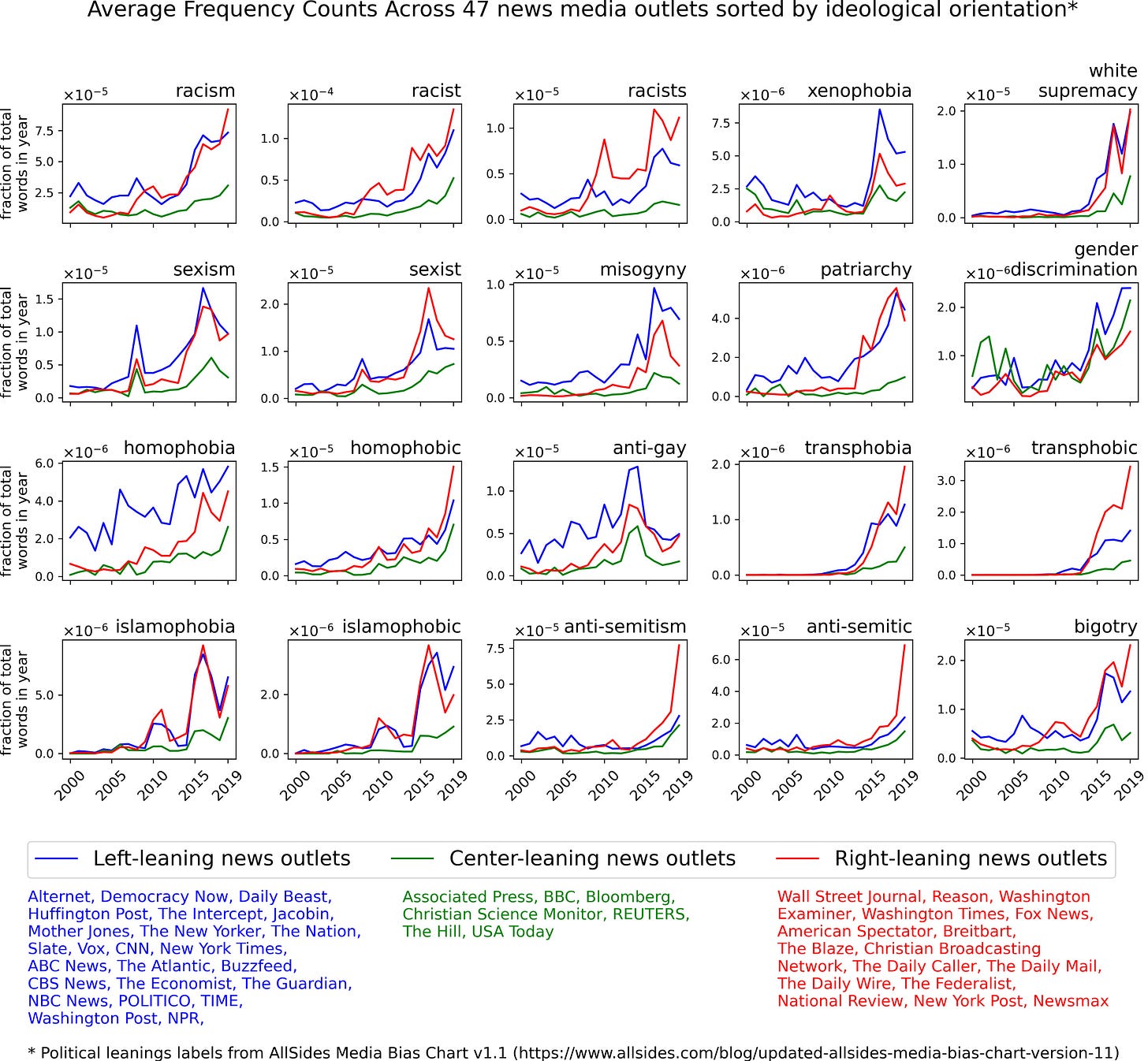The ‘Great Awokening' Preceded Trump. It May Continue Beyond Him
By David Rozado, Musa al-Gharbi and Jamin Halberstadt
Follow-up of: Prevalence of Prejudice-Denoting Words in News Media Discourse
Over the last five years, poll after poll has found that the GOP base has grown warmer towards Blacks, Hispanics, immigrants and Muslims. They’ve simultaneously become more skeptical of Christian nationalism. They’re now significantly more accepting of same sex marriage and non-discrimination protections for LGBTQ Americans. The rest of America has shifted even further in these directions.
And yet, this may be surprising to many. Based on how mainstream media outlets cover issues of identity and prejudice, you would be forgiven for assuming the trends have been heading the opposite way.
That's what we found in our recently published scholarly paper, which explored how—and how frequently—the media covered things like racism, prejudice and discrimination between 1970 and 2019. Analyzing 27 million articles from 47 of the most popular news media outlets in the United States, we identified a recent major spike in the use of terms related to most forms of prejudice and discrimination.
The increasing use of words like racism, sexism, islamophobia, or transphobia, which you can see in the graph below, was not limited to left-leaning outlets. It was pervasive across the political spectrum—in right-aligned outlets just as much as on the left. Centrist outlets did not spend as many words on prejudice and discrimination relative to their partisan peers, but their rate of increase in the usage of these words between 2010 and 2019 was similar to left and right-leaning news outlets.
But though the spike happened recently, it did not happen as recently as you might think.
It may be tempting to interpret these spikes as a reaction to the heated candidacy and presidency of Donald Trump. But our research found that the trend of increasing usage of prejudice-denoting words in news media started before the 2016 electoral cycle. In the year 2014, for example, many of the words were already at then-record highs, though we found evidence that the trend might have accelerated after 2015.
The data we analyzed in our paper was from 1970 to the end of 2019. But from our current vantage point in mid-2021, we can now get a sense of how the 2020 election cycle and Trump's subsequent exit from the White House may have affected media discussion of prejudice and discrimination. And what we found may again surprise you: Just as the skyrocketing use of words like racism, sexism, or homophobia didn't begin with Trump, his exit from the White House did not put an end to it.
We found this out when we updated our analysis, tracking the prevalence of words about prejudice in news media through 2020 and all the way to June 30, 2021. And from what we can tell, not much has changed in the last year.
It doesn't look like Trump's departure had any clear effect on the news media's use of prejudice-denoting terms. If anything, there seems to be an uptick from 2020 levels through the first half of this year—in other words, under the Biden Administration.
To confirm this, we carried out statistical tests to assess whether there could be a detectable change in the prevalence of prejudice-denoting words in news media between the five months prior to Trump's departure from the White House and the five months post-Trump. But we were unable to find a change that reached a statistical significance.
In short, there is no evidence that Trump's departure from the White House has had an effect on the media's coverage of identity issues and discrimination. In the first six months of the Joe Biden presidency, the news media continues to use prejudice-denoting words at record-high historical levels.
In other words, this isn't about Trump. The abrupt and dramatic changes in the frequency of prejudice-denoting terms in news media within the span of just 10 years suggests the existence of powerful underlying social dynamics at play. These dynamics preceded Trump's candidacy and presidency, and they seem to be continuing apace in the new administration.
It is beyond the scope of our data to identify the root causes for the dramatic increase in the prevalence of prejudice signifying words in news media organizations’ content. But, as we noted in the paper, public perceptions about the severity of bias and discrimination in the contemporary U.S. have largely tracked with the intensity of media coverage on these topics – with both increasing markedly in recent years.
It is still early in the Biden presidency to know for sure whether the "Great Awokening" in news media will continue, level off, or reverse course. Our preliminary analysis of the first half a year of the Biden presidency suggests that the phenomenon shows no sign of slowing, irrespective of who is occupying the White House.
David Rozado is an Associate Professor at Otago Polytechnic in New Zealand. His research interests are computational social science and assistive technologies. His Twitter feed is @DavidRozado
Musa al-Gharbi is a Paul F. Lazarsfeld Fellow in Sociology at Columbia University. He is the author of,We Have Never Been Woke: Social Justice Discourse, Inequality and the Rise of a New Elite, forthcoming with Princeton University Press.
Jamin Halberstadt Jamin Halberstadt is a Professor and Head of Department of Psychology at the University of Otago, in Dunedin, New Zealand. His research interests include emotion and decision making, social categorization and aesthetics, and religious cognition.




